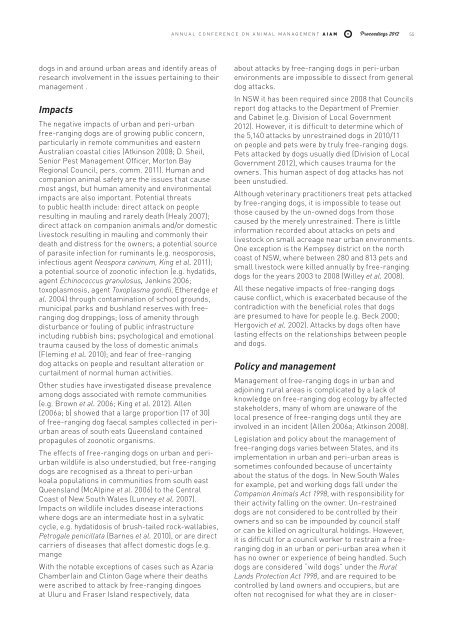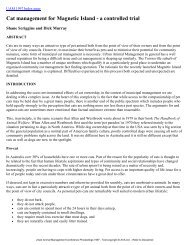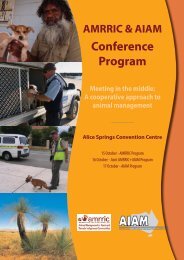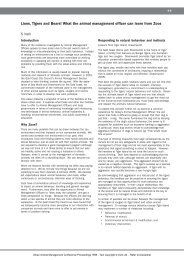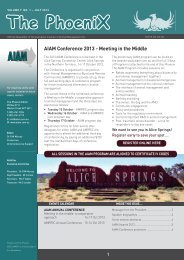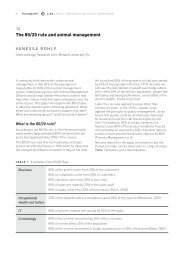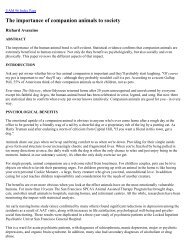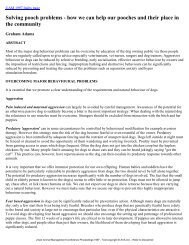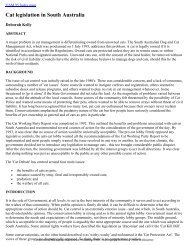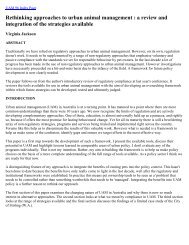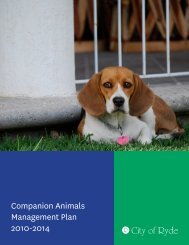Proceedings OF ThE - Australian Institute of Animal Management Inc
Proceedings OF ThE - Australian Institute of Animal Management Inc
Proceedings OF ThE - Australian Institute of Animal Management Inc
Create successful ePaper yourself
Turn your PDF publications into a flip-book with our unique Google optimized e-Paper software.
Annual Conference on <strong>Animal</strong> <strong>Management</strong> AIAM <strong>Proceedings</strong> 2012 55<br />
<strong>Management</strong> <strong>of</strong> free-ranging dogs in urban and<br />
adjoining rural areas is complicated by a lack <strong>of</strong><br />
knowledge on free-ranging dog ecology by affected<br />
stakeholders, many <strong>of</strong> whom are unaware <strong>of</strong> the<br />
local presence <strong>of</strong> free-ranging dogs until they are<br />
involved in an incident (Allen 2006a; Atkinson 2008).<br />
Legislation and policy about the management <strong>of</strong><br />
free-ranging dogs varies between States, and its<br />
implementation in urban and peri-urban areas is<br />
sometimes confounded because <strong>of</strong> uncertainty<br />
about the status <strong>of</strong> the dogs. In New South Wales<br />
for example, pet and working dogs fall under the<br />
Companion <strong>Animal</strong>s Act 1998, with responsibility for<br />
their activity falling on the owner. Un-restrained<br />
dogs are not considered to be controlled by their<br />
owners and so can be impounded by council staff<br />
or can be killed on agricultural holdings. However,<br />
it is difficult for a council worker to restrain a freeranging<br />
dog in an urban or peri-urban area when it<br />
has no owner or experience <strong>of</strong> being handled. Such<br />
dogs are considered “wild dogs” under the Rural<br />
Lands Protection Act 1998, and are required to be<br />
controlled by land owners and occupiers, but are<br />
<strong>of</strong>ten not recognised for what they are in closerdogs<br />
in and around urban areas and identify areas <strong>of</strong><br />
research involvement in the issues pertaining to their<br />
management .<br />
Impacts<br />
The negative impacts <strong>of</strong> urban and peri-urban<br />
free-ranging dogs are <strong>of</strong> growing public concern,<br />
particularly in remote communities and eastern<br />
<strong>Australian</strong> coastal cities (Atkinson 2008; D. Sheil,<br />
Senior Pest <strong>Management</strong> Officer, Morton Bay<br />
Regional Council, pers. comm. 2011). Human and<br />
companion animal safety are the issues that cause<br />
most angst, but human amenity and environmental<br />
impacts are also important. Potential threats<br />
to public health include: direct attack on people<br />
resulting in mauling and rarely death (Healy 2007);<br />
direct attack on companion animals and/or domestic<br />
livestock resulting in mauling and commonly their<br />
death and distress for the owners; a potential source<br />
<strong>of</strong> parasite infection for ruminants (e.g. neosporosis,<br />
infectious agent Neospora caninum, King et al. 2011);<br />
a potential source <strong>of</strong> zoonotic infection (e.g. hydatids,<br />
agent Echinococcus granulosus, Jenkins 2006;<br />
toxoplasmosis, agent Toxoplasma gondii, Etheredge et<br />
al. 2004) through contamination <strong>of</strong> school grounds,<br />
municipal parks and bushland reserves with freeranging<br />
dog droppings; loss <strong>of</strong> amenity through<br />
disturbance or fouling <strong>of</strong> public infrastructure<br />
including rubbish bins; psychological and emotional<br />
trauma caused by the loss <strong>of</strong> domestic animals<br />
(Fleming et al. 2010); and fear <strong>of</strong> free-ranging<br />
dog attacks on people and resultant alteration or<br />
curtailment <strong>of</strong> normal human activities.<br />
Other studies have investigated disease prevalence<br />
among dogs associated with remote communities<br />
(e.g. Brown et al. 2006; King et al. 2012). Allen<br />
(2006a; b) showed that a large proportion (17 <strong>of</strong> 30)<br />
<strong>of</strong> free-ranging dog faecal samples collected in periurban<br />
areas <strong>of</strong> south eats Queensland contained<br />
propagules <strong>of</strong> zoonotic organisms.<br />
The effects <strong>of</strong> free-ranging dogs on urban and periurban<br />
wildlife is also understudied, but free-ranging<br />
dogs are recognised as a threat to peri-urban<br />
koala populations in communities from south east<br />
Queensland (McAlpine et al. 2006) to the Central<br />
Coast <strong>of</strong> New South Wales (Lunney et al. 2007).<br />
Impacts on wildlife includes disease interactions<br />
where dogs are an intermediate host in a sylvatic<br />
cycle, e.g. hydatidosis <strong>of</strong> brush-tailed rock-wallabies,<br />
Petrogale penicillata (Barnes et al. 2010), or are direct<br />
carriers <strong>of</strong> diseases that affect domestic dogs (e.g.<br />
mange<br />
With the notable exceptions <strong>of</strong> cases such as Azaria<br />
Chamberlain and Clinton Gage where their deaths<br />
were ascribed to attack by free-ranging dingoes<br />
at Uluru and Fraser Island respectively, data<br />
about attacks by free-ranging dogs in peri-urban<br />
environments are impossible to dissect from general<br />
dog attacks.<br />
In NSW it has been required since 2008 that Councils<br />
report dog attacks to the Department <strong>of</strong> Premier<br />
and Cabinet (e.g. Division <strong>of</strong> Local Government<br />
2012). However, it is difficult to determine which <strong>of</strong><br />
the 5,140 attacks by unrestrained dogs in 2010/11<br />
on people and pets were by truly free-ranging dogs.<br />
Pets attacked by dogs usually died (Division <strong>of</strong> Local<br />
Government 2012), which causes trauma for the<br />
owners. This human aspect <strong>of</strong> dog attacks has not<br />
been unstudied.<br />
Although veterinary practitioners treat pets attacked<br />
by free-ranging dogs, it is impossible to tease out<br />
those caused by the un-owned dogs from those<br />
caused by the merely unrestrained. There is little<br />
information recorded about attacks on pets and<br />
livestock on small acreage near urban environments.<br />
One exception is the Kempsey district on the north<br />
coast <strong>of</strong> NSW, where between 280 and 813 pets and<br />
small livestock were killed annually by free-ranging<br />
dogs for the years 2003 to 2008 (Willey et al. 2008).<br />
All these negative impacts <strong>of</strong> free-ranging dogs<br />
cause conflict, which is exacerbated because <strong>of</strong> the<br />
contradiction with the beneficial roles that dogs<br />
are presumed to have for people (e.g. Beck 2000;<br />
Hergovich et al. 2002). Attacks by dogs <strong>of</strong>ten have<br />
lasting effects on the relationships between people<br />
and dogs.<br />
Policy and management


